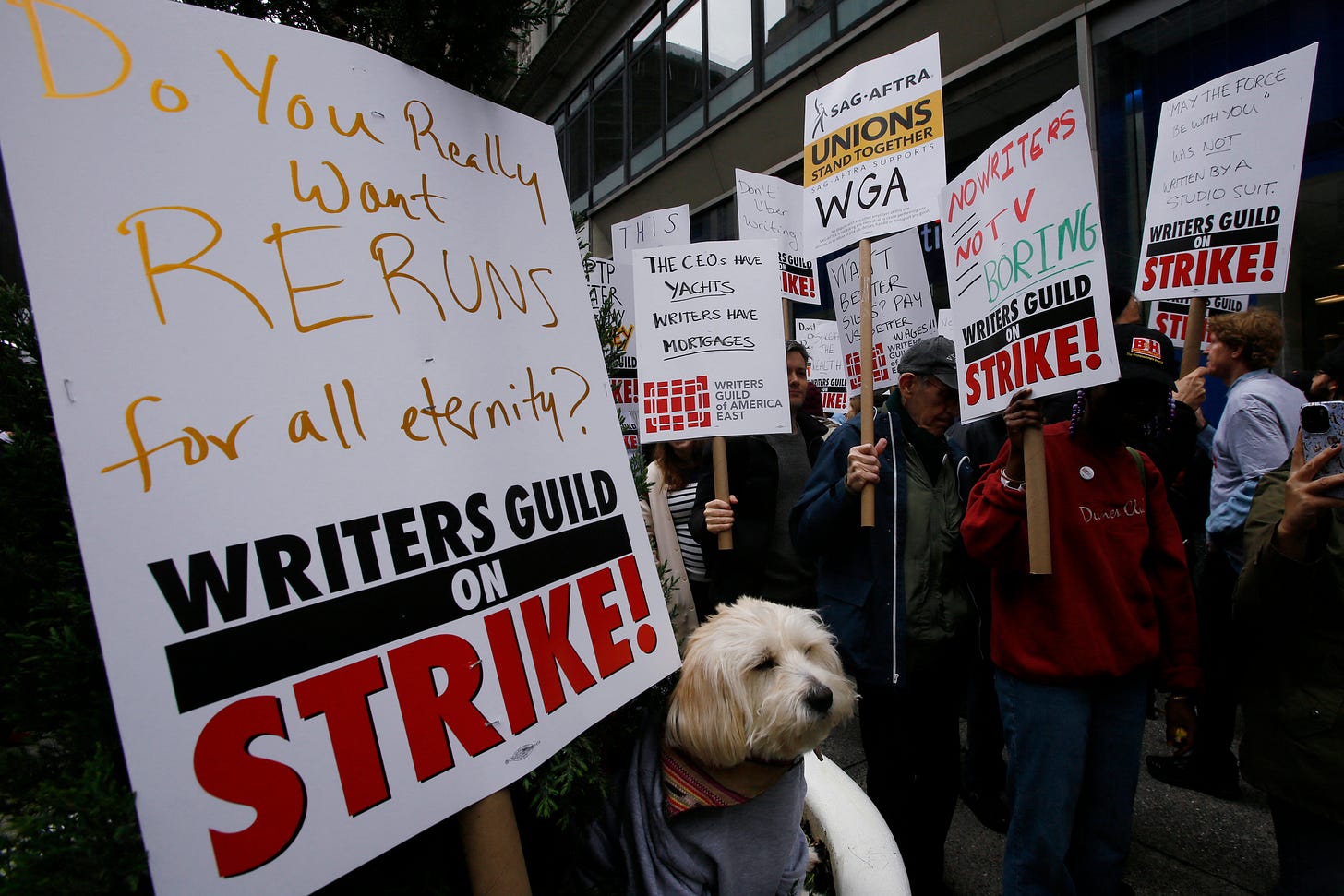Daily Digest: A Studio Exec Agrees... Mini-Rooms Suck
The most contentious issue, staffing minimums, also hurt support staff too, as both sides tell me

Happy Strike Week Four, everyone. After spending much of Week Three in New York attending upfronts (and the robust pickets outside upfronts), I’m back on the ground in L.A. and talking to writers and studio execs about one of the most contentious parts of the Writers Guild negotiations: staffing minimums, i.e. requiring that each TV series employ anywhere from six to 12 writers on a show.
To hear the AMPTP tell it, staffing minimums are one of the major “sticking points” in the studios’ now-stalled talks with the WGA — rigid quotas trying to impose a one-size-fits-all solution to the scourge of mini-rooms that only have a couple writers on staff. Would you still have White Lotus if Mike White had to employ five other writers to fill the room (instead of, incredibly, just himself)? Would it not hamper the creative process?
I chatted with support staffer Alison Golub today, a member of IATSE Local 871 (which reps writers’ assistants and script coordinators) who hasn’t been offered a union job in three years. She owes that to a staffing bottleneck happening because of mini-rooms. Micro-sized staffs mean fewer opportunities for lower-level writers, which means they “go back to being writers’ assistants or script coordinators who should be getting staffed and aren’t getting staffed,” says Golub, “so now I’m going up against people who have been doing this for 10 years — and then there are people below me who are trying to get their first job.” And so on and so forth.
“What’s the future of the industry going to look like when there are no new people coming in?” she muses. “Of all the proposals the WGA made, [staffing minimums] would definitely help assistants the most.”
Sure, you might say, of course writers and aspiring writers feel this way. But what about the people who work at Netflix and Disney and Warner Bros. and Apple? Not the David Zaslavs — he’s busy party-planning at Cannes with Graydon Carter, a day after being booed in Boston — but the rank-and-file studio executives who develop shows and interact with the angsty people now picketing outside their office windows every day?
So I called up a former senior-level studio executive who works very closely with writers to ask.
“I’m not a fan of mini-rooms — it shrinks opportunities for writers, and feels like a cost-cutting measure for the streamers who don’t want to have to commit to a series pickup until they’ve gotten all these pieces,” this studio exec tells me. “At the end of the day, it’s unsustainable for writers. It feels like the only way to stop doing mini-rooms is for creators to put their foot down and say no… but I don’t know how you would do this. If Apple wants a mini-room with three writers, you have to be willing to walk away and not have the sale. Unless you’re Ryan Murphy or Shonda [Rhimes], who has the power to walk away?”
Work for many creative execs at studios has ground to a halt during the strike. And with layoffs still bearing down on studios and production companies and agencies, asking for writers room quotas in a time of industry-wide austerity might feel like an imperfect solution to a very real problem.
“It would be great to not be forced into such a black-or-white system, but I also see the way that the studios are operating right now,” the studio exec tells me. “I understand the militant nature of the WGA in asking for these things, because the studios are going to find a way to work around it and cost-cut any way that they can.”
And many writers and their attendant support staffers already have been feeling the financial pressure for years. Golub, who is 26, works side hustles as a dog-sitter and personal assistant to make ends meet. She expects to continue those gigs through the summer. If the strike lasts through the fall, she is prepared for that as well.
“As much as it sucks and it’s hard, it’s necessary to have the strike now or else it will be too late,” she says. “A living wage means being able to pay people to afford to live in the city they live in. If you can’t afford to pay employees a living wage, you can’t afford to run a business.”
Are you a studio exec who works with writers? I want to know what you think. Talk to me: elaine@theankler.com
In Today’s Strike News
Whether you’re an optimist, a realist or a catastrophist, Vanity Fair maps out three different ways (and timelines) the strike could play out. (Vanity Fair)
Talent agencies are considering salary reductions as part of broader cost-cutting measures spurred by the strike. (Deadline)
“I don’t know if a witty sign is what gets [the AMPTP] to come back, but what it does do is keep morale high, build camaraderie, and help us remember what we’re good at, which is entertaining people,” WGA East captain Greg Iwinski tells Vulture in an in-depth explainer on everything that goes into the viral signage spotted on the picket lines. (Vulture)
Productions shut down today because of the strike: J.J. Abrams and LaToya Morgan’s Max series Duster and FX’s Jeff Bridges starrer The Old Man. (Deadline)
Picket Sign of the Day
Bad Blood on the Netflix picket line.




Great piece as always. Interesting linked article from Vanity Fair, but it asserts the strike will be LONGER if SAG-AFTRA and/or DGA also strike, which I’ve also seen suggested by McNulty. I don’t understand this. Wouldn’t having more of your workforce on strike and thus being able to produce less, thereby losing more money, cause the AMPTP to come back with a better offer quicker? Is this company propaganda seeping in or am I missing something?